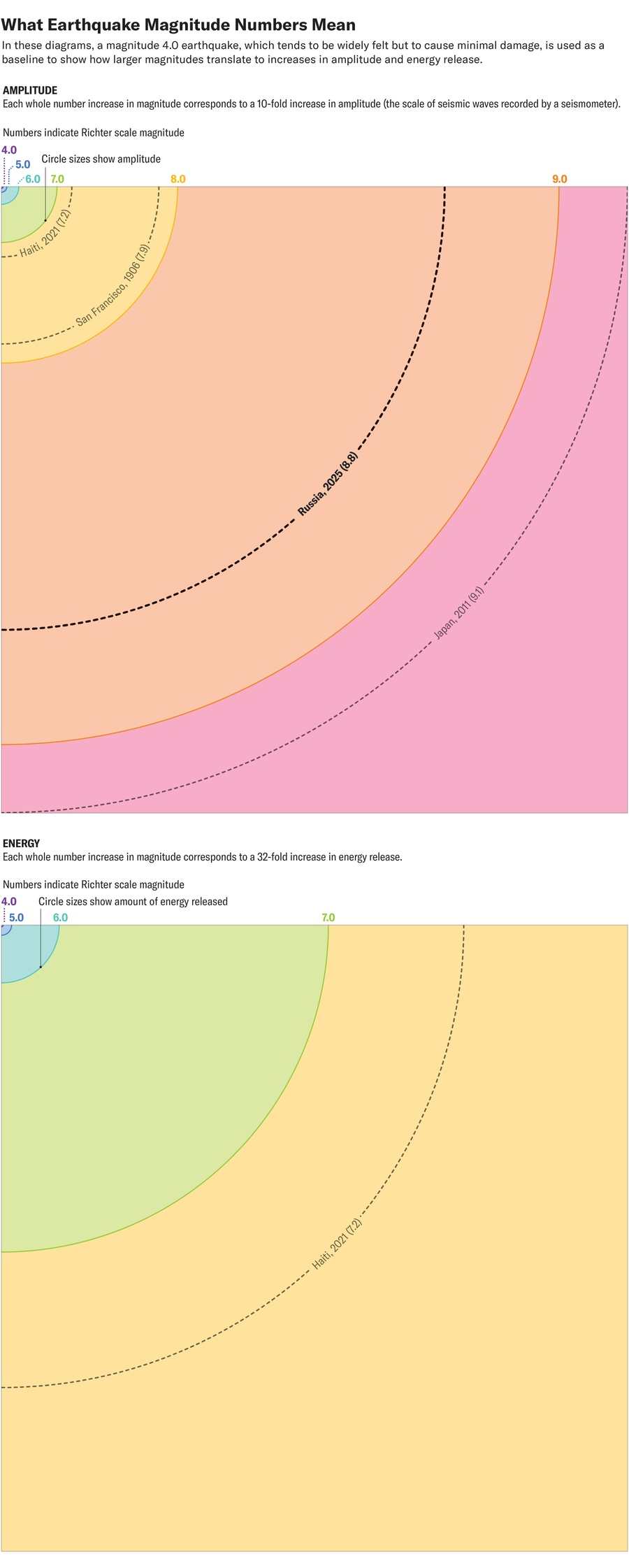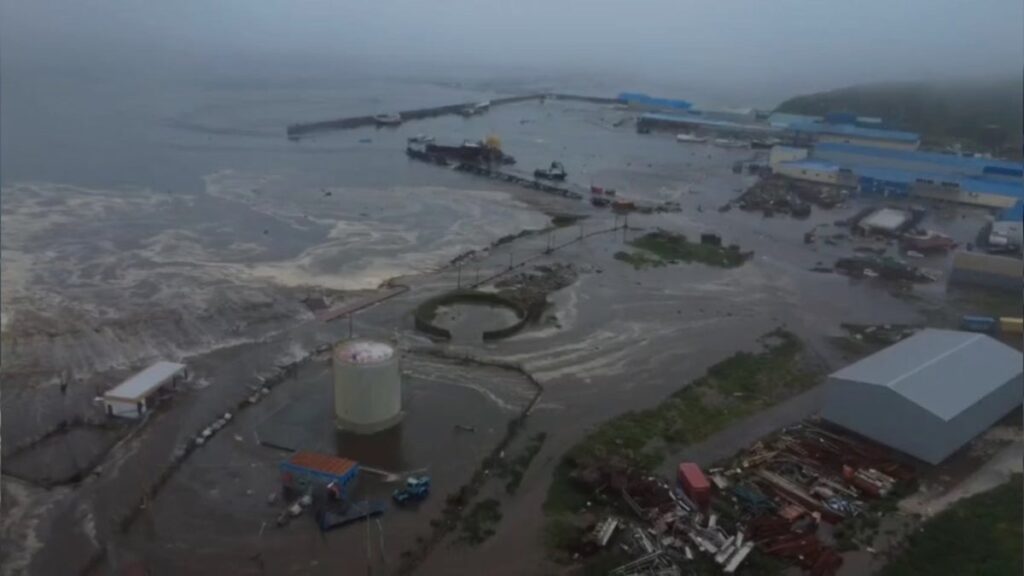Why the Russian Earthquake Didn’t Cause a Huge Tsunami
Russia’s magnitude 8.8 earthquake spawned serious tsunami warnings, but waves have been moderate so far. Here’s the geological reason why
An aerial view of the city of Severo-Kurilsk flooded due to a tsunami triggered by the 8.8 magnitude earthquake that struck off Russia’s Kamchatka Peninsula on July 30, 2025. The epicenter was located at a depth of 20.7 kilometers (12.8 miles) and was centered 119 kilometers (73.9 miles) east-southeast of Petropavlovsk-Kamchatsky. The earthquake was shallow and powerful enough to trigger waves or a tsunami.
Kamchatka of Geophysical Survey/Anadolu via Getty Images
The moment seismologists got word that a magnitude 8.8 earthquake had struck near Russia’s Kamchatka Peninsula, they felt an acute sense of anxiety. This location—where the Pacific plate is plunging below an arm of the North American plate and in the vicinity of the Eurasian plate—can produce widespread, highly destructive tsunamis. It did just that in 1952, when a magnitude 9.0 quake effortlessly washed away a nearby Russian town while also causing extensive damage in far-off Hawaii.
When the seafloor next to Kamchatka violently buckled at 11:24 A.M. local time on Wednesday (7:24 P.M. EDT on Tuesday), everything seemed primed for a dangerous tsunami. Early forecasts by scientists (correctly) predicted that several countries around the Pacific Ocean would be inundated to some degree. Millions of people were evacuated from coastal Japan, and many in Hawaii were ordered to seek higher ground. People across swaths of Central and South America were also advised to flee from the receding ocean. And as an initial smaller tsunami formed on the northern Japanese island of Hokkaido, there was some preliminary concern that waves could reach a height of nearly 10 feet.
But for the most part (at the time of writing), plenty of countries in the firing line didn’t get hit by an extremely lethal wall of water. It appears that waves of just more than four feet hit Japan and Hawaii—two locations that have now significantly downgraded their tsunami alerts and rescinded some evacuation notices. One tourist in Hawaii told BBC News that “the disaster we were expecting did not come.” Parts of California have seen water up to eight feet but without considerable damage.
On supporting science journalism
If you’re enjoying this article, consider supporting our award-winning journalism by subscribing. By purchasing a subscription you are helping to ensure the future of impactful stories about the discoveries and ideas shaping our world today.
READ MORE: Tsunami Warnings Issued after Magnitude 8.8 Earthquake Strikes off Russian Coast
This raises a key question: Considering that the Kamchatka oceanic megaquake had a magnitude of 8.8—one of the most powerful ever recorded—why wasn’t the resulting tsunami more devastating? The answer, in short, is this: the specific fault that ruptured produced pretty much exactly the tsunami it was capable of making, even if we intuitively feel like the effect should have been worse.
“First, it’s important to recognize that the issuance of any warning at all is a success story,” says Diego Melgar, an earthquake and tsunami scientist at the University of Oregon. A tsunami doesn’t have to be 30 feet tall to cause intense destruction and death; even a relatively modest one can wash people and structures away with ease. So far, it looks like there won’t be a high number of casualties—and that’s in part because “the warnings went out, and they were effective,” Melgar says: people got out of danger.
It’s also fair to say that, for Kamchatka and its surroundings, there actually was some localized destruction. The earthquake itself severely shook the eastern Russian city of Petropavlovsk-Kamchatsky and did scattered damage to buildings there. And tsunami waves reached heights of up to 16 feet in Severo-Kurilsk, a town in the northern Kuril Islands just south of Kamchatka. Houses and sections of a port have been wrecked or swept out to sea.
READ MORE: Russia’s 8.8 Earthquake Is One of the Strongest Ever Recorded
The way each nation issues a tsunami warning differs slightly. But in general, if a tsunami is very likely incoming and is thought to be potentially dangerous, an evacuation order for those on the afflicted coastline is issued. When such alerts go out, some tsunami-wave-height estimates are often given, but these numbers are initially difficult to nail down.
One reason is because, when a tsunami-making quake happens, “the tsunami energy is not distributed symmetrically,” says Amilcar Carrera-Cevallos, an independent earthquake scientist. A tsunami does not move outward in all directions with the same momentum because faults don’t rupture in a neat linear break. Nor does the seafloor movement happen smoothly and in one direction.
“Initial warnings are based only on the estimated size and location of the source, but this alone doesn’t determine how much water is displaced or where waves will concentrate,” Melgar says. “To forecast impacts accurately, scientists need to know how much the fault slipped, over what area and how close to the trench the slip occurred.” And that information is usually gleaned one or two hours after the tsunami has appeared.
A tsunami like today’s is tracked by a network of deep-ocean pressure sensors, which helps scientists update their forecasts in real time. But “the network is sparse. It doesn’t always catch the full complexity of wave energy radiating across the basin,” Melgar notes. This means it gives scientists only a partial understanding of the ocean-wide tsunami.
Another issue is that a tsunami’s wave height when the wave reaches the shore is influenced by the shape and height (technically called the bathymetry) of the seafloor it’s passing over. Tsunamis are also hindered, or helped, by the shape and nature of the coastline they slam into. “Features like bays can amplify wave heights; tsunami waves can also be diffracted (bent) around islands,” says Stephen Hicks, an earthquake scientist at University College London.
It may also be tempting to compare today’s magnitude 8.8 quake with the 2011 magnitude 9.1 quake that struck off eastern Japan, triggering a tsunami with a maximum wave height of 130 feet—one that killed more than 15,000 people. The 2004 magnitude 9.1 earthquake and tsunami in the Indian Ocean—which claimed the lives of more than 280,000 people across a vast area—may also come to mind.

That’s understandable, but today’s magnitude 8.8 quake was not quite powerful as one might think. The magnitude scale for earthquakes is not linear; in other words, a small increase in magnitude equals a huge jump in energy unleashed. According to the U.S. Geological Survey, a magnitude 9.1 quake (like the 2011 Japanese example) is nearly three times stronger than today’s.
The 2004 and 2011 cataclysms “were actually quite a lot larger than this event,” says Judith Hubbard, an earthquake scientist at Cornell University. They were simply more capable of pushing a giant volume of water across the ocean than today’s temblor.
Not knowing the exact height of an incoming tsunami at multiple locations all around the Pacific, though, is a secondary concern. What matters most is that the tsunami warnings went out to those in harm’s way quickly and accurately conveyed the times at which the tsunamis would arrive at each coastline. “The current strategy of preventative evacuation does a good job of saving lives,” Hubbard says.


